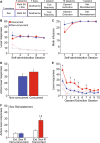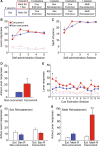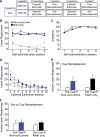Drug-taking in a socio-sexual context enhances vulnerability for addiction in male rats
- PMID: 30337639
- PMCID: PMC6333843
- DOI: 10.1038/s41386-018-0235-1
Drug-taking in a socio-sexual context enhances vulnerability for addiction in male rats
Abstract
Vulnerability to develop addiction is influenced by numerous factors, including social behavior. Specifically, in human users, drug taking in a socio-sexual context appears to enhance further drug-seeking behavior. Users report heightened sexual pleasure as a motivation for further drug use and display risk behaviors even when tested in drug-free state. Here, using a preclinical model of limited voluntary drug use in rats, the hypothesis was tested that methamphetamine (Meth)-taking concurrently with socio-sexual experience increases vulnerability to addiction. Male Sprague Dawley rats were socially housed and underwent limited-access Meth self-administration (maximum 1 mg/kg/session). Meth-taking was either concurrent or non-concurrent with sexual behavior: concurrent animals were mated with a receptive female immediately after each session, while non-concurrent animals gained equivalent sexual experience the week prior. Next, drug-seeking behaviors were measured during cue reactivity, extinction, and reinstatement sessions using different extinction and reinstatement protocols in 4 separate studies. Both groups equally acquired Meth self-administration and did not differ in total Meth intake. However, drug-seeking behavior was significantly higher in concurrent animals during cue reactivity tasks, extinction sessions, and cue- or Meth-induced reinstatement tests. In addition, sexual behavior in the absence of Meth triggered reinstatement of drug-seeking in concurrent animals. These results indicate that Meth-taking in a socio-sexual context significantly enhances vulnerability for drug addiction in male rats. This preclinical paradigm of drug self-administration concurrent with socio-sexual behavior provides a useful model for studying the underlying neurobiology of socially driven vulnerability to drug addiction.
Conflict of interest statement
The authors declare no competing interests.
Figures



Similar articles
-
Enhancement of Drug Seeking Following Drug Taking in a Sexual Context Requires Anterior Cingulate Cortex Activity in Male Rats.Front Behav Neurosci. 2020 Jun 25;14:87. doi: 10.3389/fnbeh.2020.00087. eCollection 2020. Front Behav Neurosci. 2020. PMID: 32670029 Free PMC article.
-
Sign tracking predicts cue-induced but not drug-primed reinstatement to methamphetamine seeking in rats: Effects of oxytocin treatment.J Psychopharmacol. 2020 Nov;34(11):1271-1279. doi: 10.1177/0269881120954052. Epub 2020 Oct 20. J Psychopharmacol. 2020. PMID: 33081558
-
The effects of varenicline on methamphetamine self-administration and drug-primed reinstatement in female rats.Behav Brain Res. 2016 Mar 1;300:150-9. doi: 10.1016/j.bbr.2015.11.033. Epub 2015 Nov 27. Behav Brain Res. 2016. PMID: 26638833 Free PMC article.
-
Neural mechanisms underlying incubation of methamphetamine craving: A mini-review.Pharmacol Biochem Behav. 2020 Dec;199:173058. doi: 10.1016/j.pbb.2020.173058. Epub 2020 Oct 23. Pharmacol Biochem Behav. 2020. PMID: 33250444 Free PMC article. Review.
-
The neurobiological mechanisms of physical exercise in methamphetamine addiction.CNS Neurosci Ther. 2018 Feb;24(2):85-97. doi: 10.1111/cns.12788. Epub 2017 Dec 20. CNS Neurosci Ther. 2018. PMID: 29266758 Free PMC article. Review.
Cited by
-
In vivo imaging of the GnRH pulse generator reveals a temporal order of neuronal activation and synchronization during each pulse.Proc Natl Acad Sci U S A. 2022 Feb 8;119(6):e2117767119. doi: 10.1073/pnas.2117767119. Proc Natl Acad Sci U S A. 2022. PMID: 35110409 Free PMC article.
-
Enhancement of Drug Seeking Following Drug Taking in a Sexual Context Requires Anterior Cingulate Cortex Activity in Male Rats.Front Behav Neurosci. 2020 Jun 25;14:87. doi: 10.3389/fnbeh.2020.00087. eCollection 2020. Front Behav Neurosci. 2020. PMID: 32670029 Free PMC article.
-
Kisspeptin/Neurokinin B/Dynorphin (KNDy) cells as integrators of diverse internal and external cues: evidence from viral-based monosynaptic tract-tracing in mice.Sci Rep. 2019 Oct 14;9(1):14768. doi: 10.1038/s41598-019-51201-0. Sci Rep. 2019. PMID: 31611573 Free PMC article.
-
The Protective Effect of Social Reward on Opioid and Psychostimulant Reward and Relapse: Behavior, Pharmacology, and Brain Regions.J Neurosci. 2022 Dec 14;42(50):9298-9314. doi: 10.1523/JNEUROSCI.0931-22.2022. J Neurosci. 2022. PMID: 36517252 Free PMC article. Review.
References
Publication types
MeSH terms
Substances
LinkOut - more resources
Full Text Sources
Medical

